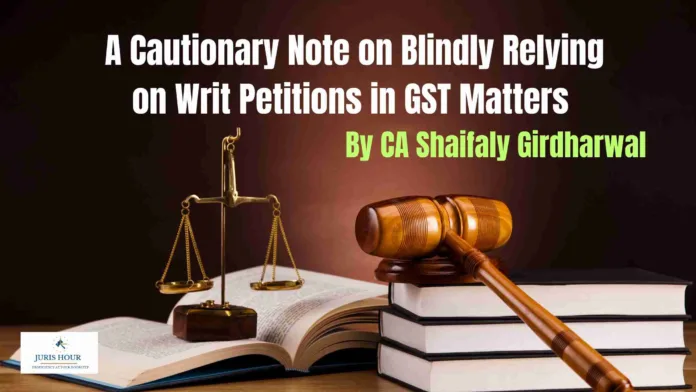This Article “A Cautionary Note on Blindly Relying on Writ Petitions in GST Matters” is authored by CA Shaifaly Girdharwal.
As someone who has navigated through years of litigation under Central Excise, Service Tax, and now GST, it is imperative to flag a growing trend: the over-reliance on writ petitions without appreciating their legal scope, binding nature, and long-term implications.
Writs are Constitutional Remedies — Not Statutory Substitutes
While Article 226 and 227 of the Constitution empower High Courts to issue writs for enforcement of legal rights, one must remember:
- Writs are discretionary and equitable remedies.
- They are not designed to replace the statutory appellate mechanism under the CGST Act.
- Departmental officers are not strictly bound by High Court writ judgments unless issued in rem or affirmed by jurisdictional High Court in binding form.
Key Risks of Relying on Writ Orders in GST Cases
- Single Bench Orders:
- Many writ decisions are passed by Single Judges without detailed statutory or factual analysis.
- These lack precedential strength and may not survive appellate or Supreme Court scrutiny.
- Sub Silentio Decisions:
- Some judgments are passed without noticing binding precedents or critical statutory provisions.
- Such decisions carry little weight and can be challenged or ignored by adjudicating authorities.
- Per Incuriam Judgments:
- Judgments that overlook relevant statutory sections or binding case laws are legally termed per incuriam.
- They are not binding even on co-ordinate benches or the same High Court.
- Non-Applicability Beyond Jurisdiction:
- A decision of, say, Kerala or Delhi High Court does not automatically bind tax officers in Maharashtra or Gujarat unless the matter is decided by the Supreme Court.
Real-World Consequences
- Assessees act on interim reliefs or writ quashings, assuming finality — only to face reversal during scrutiny or appeal.
- Reliance on weak writs has led to interest, penalty, and reopening of cases under extended limitation.
- In many cases, tribunals or appellate authorities refuse to follow such writs, leading to unnecessary litigation and financial exposure.
What to Do Instead
- Always examine whether the writ judgment is jurisdictionally applicable, in rem, and backed by sound reasoning.
- Prefer judgments passed by Division Benches or upheld in appeal.
- Use writ reliefs as temporary shields, not long-term compliance strategies.
- Ensure that internal documentation, reconciliations, and legal positions are robust — regardless of writ outcomes.
Read More: Only 4 ITRs Processed Out of 20 Lakh Filed by 13 June 2025

